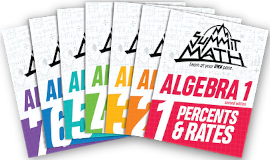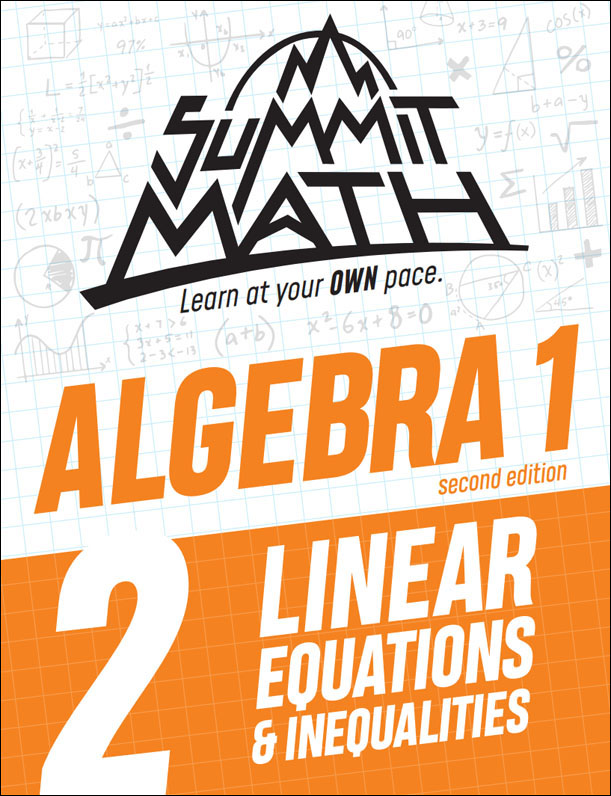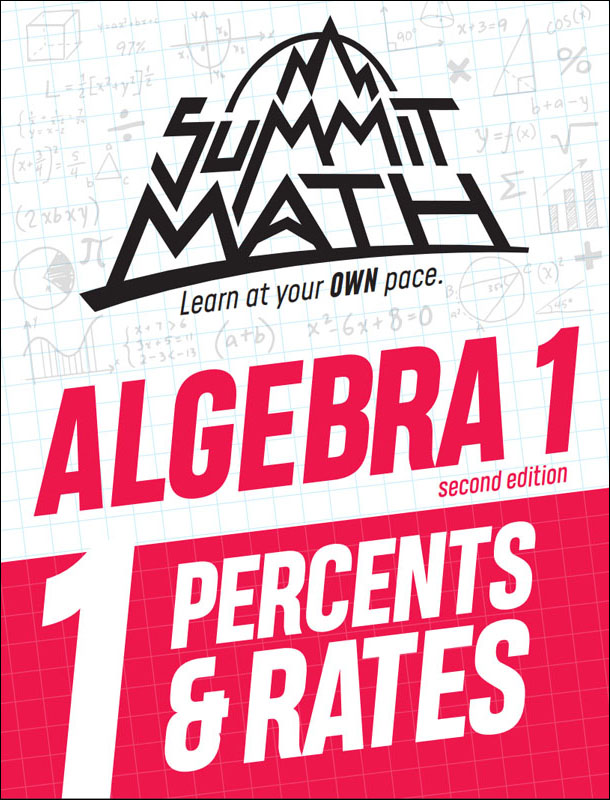Summit Math’s Algebra 1 and Algebra 2 courses are inexpensive, easy to use, and great for independent study. They also offer a unique approach that should work well for homeschoolers. Though they can be used with students in 7th and 8th grade, both courses are suitable for high school credit.
Each course is presented in several workbooks—seven for Algebra 1 and eight for Algebra 2—each addressing a particular topic. Each workbook is about 100 to 125 pages long. Workbooks can be purchased individually or as sets and in your choice of print, Kindle, and PDF formats. (Workbooks are laid out with plenty of space for students to write directly on the pages, fill in charts, work with graphs, etc., so, I recommend either the print or PDF formats unless you have a way to print pages from the Kindle-formatted books.) Both courses have free placement tests with answer keys, free tests for each workbook, and a free pacing guide (covering both courses). Optional videos provide additional teaching assistance.
The placement tests, accessible before you buy anything, are important because students who have already mastered a topic can begin with the appropriate workbook rather than completing all of them. For example, the first three workbooks of Algebra 1 cover topics students might have already mastered if they completed a rigorous pre-algebra course, and those students might be ready to start with the fourth workbook. Once students find their starting point, they should work through the workbooks in sequence since topics build upon one another. Topics covered in Algebra 1 are:
- Percents & Rates
- Linear Equations & Inequalities
- Properties of Exponents
- Operations with Polynomials
- Factoring Polynomials & Solving Quadratic Equations
- Systems of Linear Equations & Inequalities
- Radical Expressions & Equations
Topics in Algebra 2’s eight workbooks are:
- Introduction to Functions
- Linear Functions & Trend Lines
- Quadratic Equations & Parabolas
- Rational Expressions & Equations
- Rates: Motion, Work, & Interest
- Linear & Nonlinear Systems of Equations
- Exponential Functions
- The Pythagorean Theorem & Special Right Triangles
You might have noticed that Algebra 2 begins with an introduction to functions, which might sound a bit challenging. Instead, it exemplifies how the author usually introduces concepts at an easy-to-understand level. In this case, he first explains what a function is using examples such as the area of a circle being a function of the length of its radius and a person’s paycheck being a function of the number of hours worked. The gradual development of concepts and increasing complexity of the problems should make it easier for students to learn.
The courses cover the essential topics, but they introduce some topics later than other algebra courses. For instance, functions are not introduced until Algebra 2, and matrices and determinants are not covered in Algebra 2. The author is working on courses for geometry, advanced algebra, and trigonometry and precalculus, so all topics will eventually be covered. Until those courses are available, students should be able to move on from Summit Math's Algebra 2 to a precalculus course.
How the Courses Work
Both the layout of the workbooks and the lessons themselves are uniquely formatted. Each workbook is divided into two parts: Guided Discovery Scenarios provide the primary instruction and practice material, and Homework & Extra Practice Scenarios provide additional practice on topics taught in the first part. Each part has its own answer key. An unusual twist is that students are to check the answer(s) to each problem as they go.
The Guided Discovery Scenarios section of each workbook is presented in eight to ten sections. Students first complete a section in the Guided Discovery Scenarios, then go to the corresponding section in Homework & Extra Practice Scenarios.
The Guided Discovery Scenarios use a discovery approach, where students observe what is happening as they answer questions and solve problems, then form a generalization or an understanding of a rule. Word problems, often based on real-life applications, are used frequently to provide contexts for understanding and applying concepts. For instance, when the second workbook of Algebra 1 introduces the slope of a line, it does so with a discussion of the Americans with Disabilities Act’s requirement that ramps have a slope no greater than 1/12. This concrete scenario makes it easy to understand that the fraction represents rise over run. Students gradually learn more complex information with each scenario. Explanatory or instructional material is included within the scenarios, but it is brief. The Homework & Extra Practice Scenarios are laid out in the same fashion as the first part of the workbook but do not include instruction. Both parts of each workbook include a few optional problems marked with a star which are more challenging.
A cumulative review at the end of each of the two parts of every workbook helps students check their mastery of concepts before taking tests. Tests are in free Review eBooks (PDFs) that are available for both courses. Algebra 1’s has a three- or four-page test for each workbook, two pages of pre-algebra review problems, two pages of geometry problems, and an answer key. Algebra 2’s Review eBook has only tests and the answer key, and the tests range from three to five pages.
Students are expected to work independently. If they are having trouble, they can check the answer key to see if they can work toward the correct answer. If students need more assistance, you can pay for access to teaching videos that cover the Guided Discovery Scenarios. In the videos, course author Alex Joujan provides voiceover explanations as he works the problems in the Guided Discovery Scenarios. He sometimes adds explanations, helpful tips, and alerts to common errors, beyond what is included in the workbooks. Students who can grasp the concepts from the workbooks can skip the videos, but the videos should be very helpful to most students. Many sample videos can be viewed for free, and you can also use free trial periods to preview as many videos as you wish. Students should try to solve the problems on their own before watching the videos, and they should have someone who can help them if they still don’t understand a concept after watching the video.
The videos don’t cover Homework & Extra Practice Scenarios. Free Homework & Extra Practice Scenarios Homework Guides (PDF) are available for books 2 through 6 of Algebra 1 and for the first book of Algebra 2. These guides provide suggestions for solving only selected problems.
Regarding the use of calculators, at the beginning of the first book of Algebra 1, the author tells students to use a calculator when it makes sense, such as to calculate 35% of 43 (problem 6), but to try to do the mental math for simpler calculations. He also encourages students to estimate the correct answers when using a calculator to ensure that their answers are reasonable.
Summary
Summit Math’s Algebra 1 and Algebra 2 seem ideally suited for homeschoolers because of their design for independent study and options for learners who need either more or less assistance. They also stand apart from many other algebra courses with their scenario-based lessons and incremental method of instruction.










